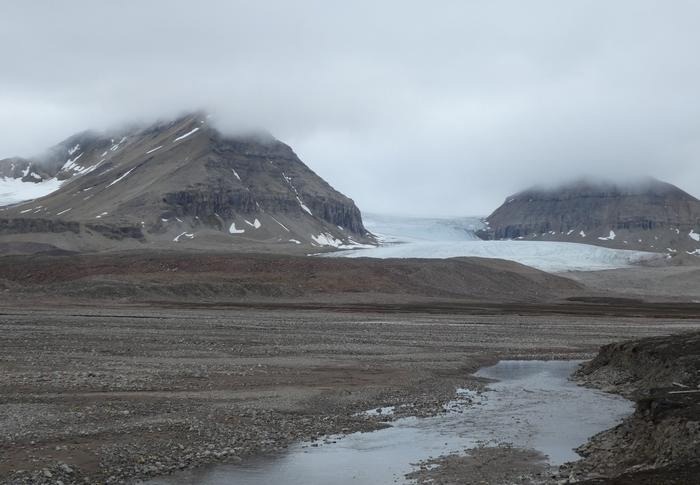Investigators from Nagoya University and Japan’s National Institute of Polar Research discovered that dust from land without snow cover in the Arctic is a significant source of particles that form ice crystals in the Arctic’s low-level clouds (at altitudes below about 3 km) during summer and fall.
 Svalbard in the Arctic in summer. Dust from the land without snow cover greatly contributes to the formation of ice crystals in the low-level clouds. Image Credit: Yutaka Tobo, National Institute of Polar Research
Svalbard in the Arctic in summer. Dust from the land without snow cover greatly contributes to the formation of ice crystals in the low-level clouds. Image Credit: Yutaka Tobo, National Institute of Polar Research
Ice crystal formation in low-level clouds is thought to impact climate since it can cause ice particles to grow at the expense of liquid droplets and then fall as precipitation, resulting in lower sunlight reflectance and a shorter lifetime for clouds.
The Arctic is said to be heating up two to four times faster than the rate of global warming. Considering that the distribution and the lifetime of low-level clouds affect climate, our finding might help improve predictions of Arctic climate change.
Dr. Kei Kawai, Study First Author, Nagoya University
The study was published in Geophysical Research Letters.
Dust is composed of very small mineral particles such as earth or sand. It serves as a nucleus for ice crystal formation in clouds. Although dust is primarily emitted from arid regions in the low or mid latitudes, recent studies have revealed that it is also released from areas in the Arctic where there is no snow, ice, or vegetation. According to previous research, such Arctic dust is an efficient nucleus for forming ice crystals because it contains a trace amount of organic matter with a high ice nucleating ability.
In the Arctic, dust is mostly emitted in summer through early fall, when the surface temperature is high and the snow cover is low. In this season, Arctic dust is distributed in the lower troposphere of the Arctic (lower than an altitude of approximately 3 km), where temperatures are warmer than about –15 °C. In general, dust particles from a desert in low or mid latitudes cannot work efficiently as nuclei to form ice crystals at temperatures warmer than –15 °C. In contrast, Arctic dust particles can work as such nuclei between –20 °C and –5 °C because of their high ice nucleating ability.
Dr. Kei Kawai, Study First Author, Nagoya University
However, the significance of Arctic dust’s high ice nucleating ability remained unknown until now because it was not taken into account in any modeling studies. To address this, Nagoya University’s Associate Professor Hitoshi Matsui and Dr. Kawai collaborated with Associate Professor Yutaka Tobo of the National Institute of Polar Research on a study using the global aerosol-climate model CAM-ATRAS.
First, they incorporated Arctic dust’s recently discovered high ice nucleating ability into their model. They then compared simulations that took this ability into account to simulations that did not. In simulations that took this ability into account, the results showed that Arctic dust acted effectively as ice nucleating particles in the Arctic region.
The simulations also closely matched observations of ice nucleating particles in several Arctic locations. Arctic dust, on the other hand, hardly acted as ice nucleating particles in simulations that did not take it into account.
The results also revealed that, due to the high ice nucleating ability of Arctic dust, the number of ice nucleating particles from dust from all over the world in the lower troposphere of the Arctic during summer and fall was enhanced by more than 100 times. In addition, almost all of the ice nucleating particles were discovered to be derived from Arctic dust.
As a result, the researchers indicated that Arctic dust dominates as ice nucleating particles in Arctic low-level clouds during the summer and fall.
We demonstrated that it is important to fully consider Arctic dust's high ice nucleating ability to clarify the distribution and the origin of ice nucleating particles in the Arctic. We hope this finding will also help us understand what is happening regarding Arctic warming and more accurately project future Arctic climate change.
Dr. Kei Kawai, Study First Author, Nagoya University
Journal Reference:
Kawai, K., et al. (2023). Dominant Role of Arctic Dust With High Ice Nucleating Ability in the Arctic Lower Troposphere. doi.org/10.1029/2022gl102470.
Source: https://en.nagoya-u.ac.jp